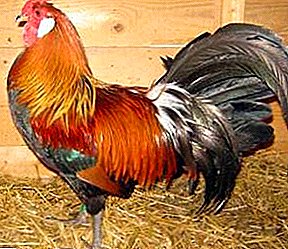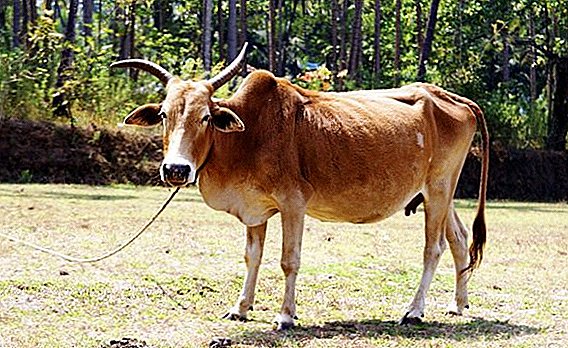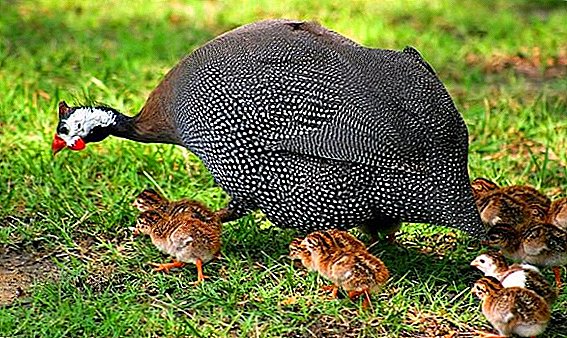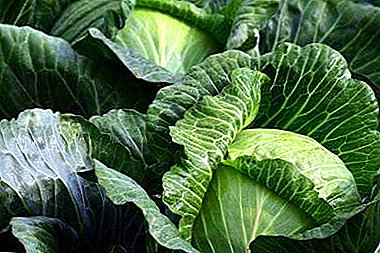
Cabbage has long been among the five most popular crops grown by Russian gardeners. After all, this vegetable can be cooked so many delicious and healthy dishes! Yes, and yields happy. Cabbage is an unpretentious crop, but some nuances make it possible to significantly increase an already quite good crop.
The surest key to success is the right choice of variety. Among the best - cabbage Rinda F1. We will discuss in our article the features of growing this wonderful cabbage and the rules for caring for it. You can also watch a useful and interesting video on this topic.
Description
This is a hybrid variety, of excellent quality. High-yielding, mid-season. Harvest in 100-120 days from germination. Rinda has dense, rounded, juicy cabbages, light green on the outside and white on the inside.. The average size of 4-5 kg, but there are warriors up to 7-8 kg.
We recommend to watch a video about the features of cabbage varieties Rinda:
History of
Cabbage hybrid was bred in Holland, but since 1993 it has been included in the state register of the Russian Federation. Checking the time this variety was successful - today it is grown everywhere.
A photo
In addition to the description below are photos of cabbage of this variety.



Difference from others
How to find out?
The plant is low, squat, on a short leg. The leaves are thin, delicate. Heads neat, smooth. Wax coating is insignificant.
For what purposes to grow?
Rinda - Universal Cabbage. Ideal for winter preparations: pickling and salads. But in the heads perfectly kept. Tasty in fresh and stewed form.
Grade advantages:
- Does not crack.
- The variety is disease resistant.
- Excellent seed germination.
- Gives a friendly harvest.
- Feels great in different climatic zones.
- Attractive appearance and excellent transportability make this variety ideal for sale.
- Subject to the necessary conditions can be stored up to 3-4 months.
- It withstands low temperatures.
- Excellent taste varieties.
Grade Disadvantages:
- This variety is light-requiring. In the shade to get a good harvest will not work.
- Requires good watering. Rinda does not tolerate drought.
Features of growing
Landing
 Cabbage can be planted seedlings or seeds directly into the soil. Rindu seedlings are usually sown in mid-March - early April. About a month before landing in the ground. Of course, we must take into account the peculiarities of your region. Seeds are placed in moist soil (greenhouse or box), having previously treated it with a weak solution of potassium permanganate. Deepen the seeds no more than 1-2 cm. Until the emergence of shoots, it is better to cover planting film.
Cabbage can be planted seedlings or seeds directly into the soil. Rindu seedlings are usually sown in mid-March - early April. About a month before landing in the ground. Of course, we must take into account the peculiarities of your region. Seeds are placed in moist soil (greenhouse or box), having previously treated it with a weak solution of potassium permanganate. Deepen the seeds no more than 1-2 cm. Until the emergence of shoots, it is better to cover planting film.
Do not forget to air daily! After two weeks, the young cabbage can be seated on individual containers. Planting on a permanent place begin after the appearance of 3-4 true leaves. Cabbage is not afraid of lowering the temperature. Dangerous for seedlings - drying out of the soil and lack of light.
When sown with seeds, the dates shift to April - May. To accelerate growth, you can use the landing under the half of a plastic bottle, which plays the role of a mini-greenhouse. In this case, 4-5 seeds are sown per well. After the emergence of seedlings leave one of the most powerful plant, remove the rest carefully, without damaging the roots of the main one.
A place
It is advisable to take a flat bed under the cabbage. A very important point - avoid shady places!
The soil
The soil does not require special preparation. Enough digging and making humus. You can add a small amount of sifted ash - to combat early pests and additional food. Cabbage prefers neutral acidity of the soil.
Good to plant cabbage after onions, garlic, potatoes, legumes, zucchini. Bad predecessors - all cruciferous.
Landing density
When planting seedlings take into account - the distance should be sufficient for the development of an adult plant (from 40 to 60 cm)!
Temperature
The optimum temperature for germination is about 20-22 degrees, then you can lower it to 10 degrees.
Landing
For a permanent place, cabbage is better to replant in cloudy weather, or in the eveningto avoid wilting immature plants. If this is not possible, apply a landing paper or covering material.
Watering
Cabbage plant moisture-loving. Watering is better to produce it at the root of 1 l per plant (at least 2-3 times a week). The lack of moisture is easy to notice - the leaves of the plant are wilted and flabby. If the cabbage looks juicy and cheerful - you can safely postpone watering.
Measures to increase yield
 Beneficial effect on crop loosening (at least 1 time per week). A crust cannot be formed on the surface of the earth after watering; this makes it difficult for oxygen to reach the roots.
Beneficial effect on crop loosening (at least 1 time per week). A crust cannot be formed on the surface of the earth after watering; this makes it difficult for oxygen to reach the roots.
If necessary (if the plants are frail, pale, drawn out), fertilizing can be done with a solution of mullein, urea, or ammonium nitrate.
Hilling of plants is recommended to be carried out 2 times a season.. The first time - 2 weeks after disembarkation, the second time - in two months.
Harvesting
Rinda F1 cabbage ripening occurs at the end of August - beginning of September. Cleaning is best done on days when precipitation is not expected. The cabbages are cut with a knife, stripped of excess leaves and sent to storage.
Storage
This variety is usually used for souring. If you do not like this option, then Rindu can be stored in the basement.
One of the storage options - in limbo. In this case, the cabbage is not cut, but pulled out together with the root, for which further placement of heads takes place. Dirt and excess soil must be removed. This method increases the storage time.
Optimum storage conditions for cabbage:
- Air temperature: 0 +2 degrees.
- Humidity: about 80%.
- Regular airing.
Diseases and pests - prevention and control
Rinda is resistant to diseases, but as a prophylactic drug, Fitosporin can be used.. It is possible to apply both to seedling, and to adult plants.
If your cabbage has undergone the disease, then you should first determine it.
The most dangerous diseases
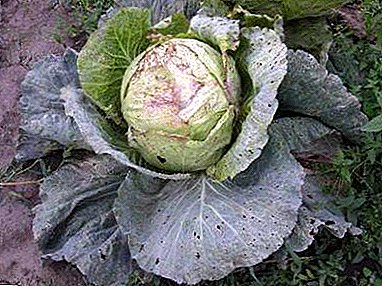 Blackleg. A disease in which fungi infect the basal part of the stem. The disease leads to the death of the plant. In case of detection of infected cabbage, it should be removed immediately and preferably burned. When damaged by a black leg, the leaves of the plant often acquire a pink or purple hue, becoming lethargic. The stalk at the site of the lesion becomes thinner, as if transmitted. For prophylaxis, use the previously mentioned phytosporin.
Blackleg. A disease in which fungi infect the basal part of the stem. The disease leads to the death of the plant. In case of detection of infected cabbage, it should be removed immediately and preferably burned. When damaged by a black leg, the leaves of the plant often acquire a pink or purple hue, becoming lethargic. The stalk at the site of the lesion becomes thinner, as if transmitted. For prophylaxis, use the previously mentioned phytosporin.- Quila. Kiel fungus settles on the roots - whitish putrid thickenings. Externally manifested in the underdevelopment of the heads, the leaves may turn yellow and fade. The disease is not treated. The affected plants must be destroyed, the soil shed strong infusion of potassium permanganate. In the spring, before sowing seeds or seedlings, treat the ground with a 3% solution of Bordeaux mixture.
- Downy mildew. Yellowish or grayish spots appear on the leaves. Gradually affected leaves die off. Phytosporin helps here!
Major pests
Cabbage is very fond of garden pests. Consider what they are dangerous and how to deal with them.
- Aphid. Clusters of these small insects, gray or green, are easy to detect on the back of the leaf. Aphid is dangerous because it draws juice from the plant. The leaves are deformed and curled.
- Cruciflo flea. Dangerous for the cruciferous family. Especially for young seedlings! Able to completely destroy the plant in a couple of days. The first signs of small holes in the leaves. The pests themselves: black bugs, jumping like real fleas.
- Scoop. Butterfly caterpillars are dangerous. Damages heading to the very center, making it unsuitable for storage.
- Cruciferous bug. Beetle bright colors (black pattern on a red or yellow background). Both bedbugs and their larvae are dangerous. Ways to combat these pests are the same - it is necessary to treat the plants with an insecticide! It is recommended to carry out 2-3 treatments with a break of 1-2 weeks at the first manifestation of pests. For example, Fitoverm - it is low toxic and safe. Dilute the drug at the rate of 4 ml per 1 liter of water.
We recommend watching a video about cabbage pests and ways to combat them:
Folk methods of struggle
- Can help planting near cabbage unloved pests of plants. Successfully combine planting cabbage with garlic, coriander or onion.
- You can drive away cruciferous flea by decorating beds with cabbage with flowers of marigolds, nasturtiums and calendula.
- You can powder the leaves of Rinda with a mixture of tobacco dust and ash.
We recommend watching a video about folk methods of cabbage pests control:
Conclusion
Observing our recommendations, by the autumn you will receive an excellent harvest of cabbage - after all, the Rinda variety is so popular among summer residents and farmers!


 Blackleg. A disease in which fungi infect the basal part of the stem. The disease leads to the death of the plant. In case of detection of infected cabbage, it should be removed immediately and preferably burned. When damaged by a black leg, the leaves of the plant often acquire a pink or purple hue, becoming lethargic. The stalk at the site of the lesion becomes thinner, as if transmitted. For prophylaxis, use the previously mentioned phytosporin.
Blackleg. A disease in which fungi infect the basal part of the stem. The disease leads to the death of the plant. In case of detection of infected cabbage, it should be removed immediately and preferably burned. When damaged by a black leg, the leaves of the plant often acquire a pink or purple hue, becoming lethargic. The stalk at the site of the lesion becomes thinner, as if transmitted. For prophylaxis, use the previously mentioned phytosporin.
